|
Presenter: Dr. Steve WaiChing Sun, Columbia University Title: Some applications of graph theory in data-driven multi-scale mechanics Video: Watch a recording of the seminar Abstract: In this talk, we will share our experience in using undirected and directed graphs to solve computational solid mechanics problems with a variety of deep neural networks. In the first half of the talk, we will focus on the usage of undirected weighted graphs that represent the microstructures. We will demonstrate 1) how to effectively represent microstructures such as polycrystals, granular assemblies and composites as node-weighted graphs, a network of nodes with assigned attributes connected by edges, 2) how to create low-dimensional topological descriptors via graph convolution neural network that exhibits spatial and rotational invariance properties and 3) how these topological descriptors can be used to enhance the accuracy and robustness of the forward predictions and generalize the surrogate constitutive models generated via semi-supervised learning. In the second half of the talk, we will examine the application of directed multi-graphs that represent causality/relational knowledge of material laws. By idealizing the process of modeling constitutive laws as a multi-player game, we will examine 4) how the process of writing, validating and falsifying a constitutive law can be formulated as a Markov decision process, and 5) how a model-free deep reinforcement learning paradigm can introduce artificial intelligence (AI) modelers and experimentalists that learn to create hand-crafted-like constitutive models through competitions and repeated trial and errors. Examples will be provide to illustrate how these self-interacting, self-improving AI agents discover new hidden hierarchical structures of mechanics knowledge, spot the weakness of existing models and create new approaches to incorporate non-Euclidean data traditionally excluded in constitutive laws to make predictions more accurate and robust.
0 Comments
 Our postdoctoral research scientist Chuanqi Liu has just received an offer from the Institute of Mechanics in the Chinese Academy of Sciences (CAS). He is selected by the 100 talent program (pioneering project) of CAS and is offered the position as an associate professor. During his tenure with us, Chuanqi has been a productive member of our team and has published the following peer-reviewed articles:
Congratulations, Chuanqi! We present a new thermal-mechanical-chemical-phase field model that captures the multi-physical coupling effects of precipitation creeping, crystal plasticity, anisotropic fracture, and crack healing in polycrystalline rock at various temperature and strain-rate regimes. This model is solved via a fast Fourier transfer solver with an operator-split algorithm to update displacement, temperature and phase field, and chemical concentration incrementally. In nuclear waste disposal in salt formation, brine inside the crystal salt may migrate along the grain boundary and cracks due to the gradient of interfacial energy and pressure. This migration has a significant implication on the permeability evolution, creep deformation, and crack healing within rock salt but is difficult to incorporate implicitly via effective medium theories compared with computational homogenization. As such, we introduce a thermodynamic framework and a corresponding computational implementation that explicitly captures the brine diffusion along the grain boundary and crack at the grain scale. Meanwhile, the anisotropic fracture and healing are captured via a high-order phase field that represents the regularized crack region in which a newly derived non-monotonic driving force is used to capture the fracture and healing due to the solution precipitation. Numerical examples are presented to demonstrate the capacity of the thermodynamic framework to capture the multiphysics material behaviors of rock salt. This paper is Part II of our work on modeling polycrystal salt for nuclear waste disposal. Reference
While crack nucleation and propagation in the brittle or quasi-brittle regime can be predicted via variational or material-force-based phase field fracture models, these models often assume that the underlying elastic response of the material is non-polar and yet a length scale parameter must be introduced to enable the sharp cracks represented by a regularized implicit function. However, many materials with internal microstructures that contain surface tension, micro-cracks, micro-fracture, inclusion, cavity or those of particulate nature often exhibit size-dependent behaviors in both the path-independent and path-dependent regimes. This paper is intended to introduce a unified treatment that captures the size effect of the materials in both elastic and damaged states. By introducing a cohesive micropolar phase field fracture theory, along with the computational model and validation exercises, we explore the interacting size-dependent elastic deformation and fracture mechanisms exhibits in materials of complex microstructures. To achieve this goal, we introduce the distinctive degradation functions of the force-stress-strain and couple-stress-micro-rotation energy-conjugated pairs for a given regularization profile such that the macroscopic size-dependent responses of the micropolar continua is insensitive to the length scale parameter of the regularized interface. Then, we apply the variational principle to derive governing equations from the micropolar stored energy and dissipative functionals. Numerical examples are introduced to demonstrate the proper way to identify material parameters and the capacity of the new formulation to simulate complex crack patterns in the quasi-static regime. [manuscript] One key drawback of classical discrete/distinct/granular element methods for particulate mechanics is that they cannot generate any kinetic and kinematics information at the sub-grain scales. Nevertheless, many dissipative mechanisms of granular materials are actually originated from path-dependent behaviors at the sub-grain scales where wear, damage, fracture and fragmentation occurs. This simplification therefore may lead to a departure of force chain topology and therefore make the resultant simulations inaccurate. Recovery of these sub-scale information while capturing the geometry and form of each individual grains is inherently a difficult task.
In this work, our postdoc Dr. Chuanqi Liu introduces an implicit material point method designed to bypass meshing of bodies by employing level set functions to represent boundaries at structured grids. This implicit function representation provides an elegant means to link an unbiased intermediate reference surface with the true boundaries by closest point projection as shown Leichner et al. 2019. We then enforce the contact constraints by a penalty method where the Coulomb friction law is implemented as an elastoplastic constitutive model such that a return mapping algorithm can be used to provide constitutive updates for both the stick and slip states. To evolve the geometry of the contacts properly, the Hamilton-Jacobi equation is solved incrementally such that the level set and material points are both updated according to the deformation field. To improve the accuracy and regularity of the numerical integration of the material point method, a moving least square method is used to project numerical values of the material points back to the standard locations for Gaussian-Legendre quadrature. Several benchmarks are used to verify the proposed model. Comparisons with discrete element simulations are made to analyze the importance of stress fields on predicting the macroscopic responses of granular assemblies. [manuscript] In recognition of his groundbreaking research illuminating the mechanics and physics of porous geomaterials like rocks, soil, concrete and salt, Professor Steve WaiChing Sun has earned the prestigious John Argyris Award for Young Scientists. This award is given by the International Association for Computational Mechanics (IACM).
Bridging mathematical science, theoretical mechanics, and industrial applications, Sun’s interests focus on computational poromechanics and geomechanics for a variety of applications, ranging from carbon dioxide storage to disposal of nuclear waste. In addition to the John Argyris award, Sun has received several prominent international awards in theoretical and computational mechanics, including the Zienkiewicz Numerical Methods in Engineering Prize from Institution of Civil Engineers (UK), the ASCE Engineering Mechanics Institute Leonardo de Vinci Award (USA), Dresden Fellowship (Germany), as well as the young investigator awards from funding agencies, including the US National Science Foundation CAREER Award, the US Air Force Young Investigator Program Award, and the US Army Young Investigator Program Award. Highlighting distinguished scholarship and outstanding accomplishments, the biennial John Argyris Award for Young Scientists celebrates influential researchers 40 and under. Sun, an assistant professor of civil engineering and engineering mechanics since 2014, will be the first Columbia faculty member and the first Chinese American to receive this honor. He will receive the award at the opening ceremony for the joint organization of the 14th IACM World Congress in Computational Mechanics and the 8th European Congress on Computational Methods in Applied Science and Engineering this summer in Paris. [URL] My colleagues and I have obtained the approval from the board of governors of ASCE EMI to establish a new committee in the ASCE Engineering Mechanics Institute for applying machine learning to AI. The first meeting for this new committee will occur during the ASCE EMI conference at Columbia University this coming May. See [URL]
Abstract: This paper examines the frame-invariance (and the lack thereof) exhibited in simulated anisotropic elasto-plastic responses generated from supervised machine learning of classical multi-layer and informed-graph-based neural networks, and proposes different remedies to fix this drawback. The inherent hierarchical relations among physical quantities and state variables in an elasto-plasticity model are first represented as directed graphs, where three variations of the graph are tested. While feed-forward neural networks are used to train path-independent constitutive relations (e.g., elasticity), recurrent neural networks are used to replicate responses that depends on the deformation history, i.e. or path dependent. In dealing with the objectivity deficiency, we use the spectral form to represent tensors and, subsequently, three metrics, the Euclidean distance between the Euler Angles, the distance from the identity matrix, and geodesic on the unit sphere in Lie algebra, can be employed to constitute objective functions for the supervised machine learning. In this, the aim is to minimize the measured distance between the true and the predicted 3D rotation entities. Following this, we conduct numerical experiments on how these metrics, which are theoretically equivalent, may lead to differences in the efficiency of the supervised machine learning as well as the accuracy and robustness of the resultant models. Neural network models trained with tensors represented in component form for a given Cartesian coordinate system are used as a benchmark. Our numerical tests show that, even given the same amount of information and data, the quality of the anisotropic elasto-plasticity model is highly sensitive to the way tensors are represented and measured. The results reveal that using a loss function based on geodesic on the unit sphere in Lie algebra together with an informed directed graph yield significantly more accurate rotation prediction than the other tested approaches. [PDF] Abstract: This paper presents the application of a fast Fourier transform (FFT) based method to solve two phase field models designed to simulate crack growth of strongly anisotropic materials in the brittle regime. By leveraging the ability of the FFT-based solver to generate solutions with global continuities, we design two simple algorithms to capture the complex fracture patterns (e.g. sawtooth, and curved crack growth) common in materials with strongly anisotropic surface energy via the multi-phase-field and high-order phase-field frameworks. A staggered operator-split solver is used where both the balance of linear momentum and the phase field governing equations are formulated in the periodic domain. The unit phase field of the initial failure region is prescribed by the penalty method to alleviate the sharp material contrast between the initial failure region and the base material. The discrete frequency vectors are generalized to estimate the second and fourth order gradients such that the Gibbs effect near shape interfaces or jump conditions can be suppressed. Furthermore, a pre-conditioner is adopted to improve the convergence rate of the iterative linear solver. Three numerical experiments are used to systematically compare the performance of the FFT-based method in the multi-phase-field and high-order phase-field frameworks. [PDF] A phase field framework for capillary-induced fracture in unsaturated porous media: drying-induced vs. hydraulic cracking Abstract: This article introduces a unified mathematical framework to replicate both desiccation-induced and hydraulic fracturing in low-permeable unsaturated porous materials observed in experiments. The unsaturated porous medium is considered as a three-phase solid-liquid-gas effective medium of which each constituent occupies a fraction of the representative elementary volume. As such, an energy-minimization-based phase-field model (PFM) is formulated along with the Biot's poroelasticity theory to replicate the sub-critical crack growth in the brittle regime. Unlike hydraulic fracturing where the excess pore liquid pressure plays an important role at the onset and propagation of cracks, desiccation cracks are mainly driven by deformation induced by water retention. Therefore, the wettability of the solid skeleton may affect the evolution of the capillary pressure (suction) and change the path-dependent responses of the porous media. This air-water-solid interaction may either hinder or enhance the cracking occurrence. This difference of capillary effect on crack growth during wetting and drying is replicated by introducing retention-sensitive degradation mechanisms in our phase field fracture approach. To replicate the hydraulic behaviors of the pore space inside the host matrix and that of the cracks, the path-dependent changes of the intrinsic permeability due to crack growth and porosity changes are introduced to model the flow conduit in open and closed cracks. Numerical examples of drying-induced and hydraulic fracturing demonstrate the capability of the proposed model to capture different fracture patterns, which qualitatively agrees with the fracture mechanisms of related experiments documented in the literature. [PDF] We are a part of the multi-university team who has been awarded a 2 million grant for leveraging interpretable augmented intelligence for multiscale discovery.
Award Abstract #1940203 Collaborative Research: I-AIM: Interpretable Augmented Intelligence for Multiscale Material Discovery NSF Org:Office of Advanced Cyberinfrastructure (OAC) ABSTRACT The ability to model, predict, and improve the mechanical performance of engineering materials such as polymers, composites, and alloys can have a significant impact on manufacturing, with important economic and societal benefits. As advanced computational algorithms and data science approaches become available, they can be harnessed to disrupt the current approaches to materials modeling, and allow for the design and discovery of new high-strength, high-performance materials for manufacturing. Bringing together multidisciplinary teams of researchers can maximize the impact of these new tools and techniques. This Harnessing the Data Revolution Institutes for Data-Intensive Research in Science and Engineering (HDR-I-DIRSE) award supports the conceptualization of an Institute to develop novel data science methods, address fundamental scientific questions of Materials Engineering and Manufacturing, and build such multidisciplinary teams. The project will apply novel data science methods to advance the analysis of large sets of structural data of composite materials and alloys from the atomic scale to correlate with and predict mechanical properties. The methods are based on machine learning techniques and uncertainty quantification, and will help uncover underlying structural features in the materials that determine the properties and performance. The methods and results will help accelerate the development of ultra-high strength and lightweight carbon-based composites for aerospace applications, and multi-element superalloys for more durable engine parts, by navigating in the large possible design space and providing faster predictions than experiments and traditional simulation methods. The project will also lead to new methods and computational algorithms that will become publicly available. The investigators will train graduate and undergraduate students from various disciplines with a focus on engaging women and minorities in STEM fields, develop short courses that integrate novel Materials Science and Engineering applications and Data Science methods, and foster vertical integration of interdisciplinary research from undergraduate students to senior scientists. This project aims at building an effective and interpretable learning framework for materials data across scales to solve a major challenge in current data-driven materials design. The combined Materials Science and Data Science approaches will synergistically contribute to the development and use of interpretable and physics-informed data science methodologies to gain new understanding of mechanical properties of polymer composites and alloys, with the potential to be expanded into different property sets and different systems. The PIs will utilize available data efficiently through combination with physical rules and prior knowledge, to develop an interpretable augmented intelligent system to learn principles behind the association of input structures with material properties with uncertainty quantification. The interconnected tasks involve the (1) collection and curation of large amounts of computational and experimental data for polymer/carbon nanotube composites and alloys from open data sources and targeted calculations and experiments, (2) the development of geometric and topological methods incorporating physical principles to generate a better, more sensitive low-dimensional representation of the multidimensional data and characterize the parameter space related to mechanical properties, (3) the development of a Bayesian deep reinforcement learning framework to generate interpretable knowledge graphs that depict the relational knowledge among physical quantities with uncertainty quantification, and (4) the prediction of mechanical properties to reveal design principles to improve materials performance, evaluate and validate the methods, and develop software for dissemination. This project is part of the National Science Foundation's Harnessing the Data Revolution (HDR) Big Idea activity and is co-funded by the Division of Civil, Mechanical and Manufacturing Innovation. This award reflects NSF's statutory mission and has been deemed worthy of support through evaluation using the Foundation's intellectual merit and broader impacts review criteria. More information can be found in the official announcement from NSF [URL]. A configurational force for adaptive re-meshing of gradient-enhanced poromechanics problems with history-dependent variables SeonHong Na, Eric C Bryant, Waiching Sun We introduce a mesh-adaption framework that employs a multi-physical configurational force and Lie algebra to capture multi-physical responses of fluid-infiltrating geological materials while maintaining the efficiency of the computational models. To resolve sharp changes of both displacement and pore pressure, we introduce an energy-estimate-free re-meshing criterion by extending the configurational force theory to consider the energy dissipation due to the fluid diffusion and the gradient-dependent plastic flow. To establish new equilibria after re-meshing, the local tensorial history-dependent variables at the integration points are first decomposed into spectral forms. Then, the principal value and direction are projected onto a smooth field interpolated by the basis function of the finite element space via the Lie-algebra mapping. Our numerical results indicate that this Lie algebra operator, in general, leads to a new trial state closer to the equilibrium than the ones obtained from the tensor component mapping approach. A new configurational force for dissipative fluid-infiltrating porous materials that exhibit gradient-dependent plastic flow is introduced such that the re-meshing may accommodate the need to resolve the sharp pressure gradient as well as the strain localization. The predicted responses are found to be not influenced by the mesh size due to the micromorphic regularization, while the adaptive meshing enables us to capture the width of deformation bands without the necessity of employing fine mesh everywhere in the domain. [PDF] 2019-07-29
#1971999 - A Cooperative Two-player Game for Data-driven Discovery of Elasto-plasticity Knowledge Represented in Directed Graph 02:00 - 02:20 Minisymposium#203 Data-driven Modeling Using Uncertainty Quantification, Machine Learning and Optimization Authors Kun Wang ,WaiChing Sun * ,Qiang Du LocationR oom # Lone Star Ballroom F - LVL 3 We introduce a multi-agent meta-modeling game to generate data, knowledge, and models that make predictions on constitutive responses of elasto-plastic materials. We introduce a new concept from graph theory where a modeler agent is tasked with evaluating all the modeling options recast as a directed multigraph and find the optimal path that links the source of the directed graph (e.g. strain history) to the target (e.g. stress) measured by an objective function. Meanwhile, the data agent, which is tasked with generating data from real or virtual experiments (e.g. molecular dynamics, discrete element simulations), interacts with the modeling agent sequentially and uses reinforcement learning to design new experiments to optimize the prediction capacity. Consequently, this treatment enables us to emulate an idealized scientific collaboration as selections of the optimal choices in a decision tree search done automatically via deep reinforcement learning. 2019-07-31 #1971644 - Data-driven Validation of Bishop’s Effective Stress Principle through Deep Reinforcement Learning 02:20 - 02:40 Minisymposium#105 Computational Geomechanics, in honor of Prof. Mary F. Wheeler Authors Yousef Heider * ,Kun Wang ,Hyoung Suk Suh ,WaiChing Sun Location Room # Lone Star Ballroom C - LVL 3 In analogy to Terzaghi’s effective stress principle in fully-saturated porous media, Bishop’s effective stress principle presents a partition of the total stress in unsaturated porous media between suction and effective stress contributions. Although widely applied in Geomechanics, the validity and generality of Bishop’s principle across saturation regimes still a matter of debate, especially for path-dependent materials that exhibit hysteresis retention behaviors. The proposed meta-modeling automated learning approach makes use of data-based constitutive modeling, generated via reinforcement learning, to evaluate the validity and generality of Bishop’s effective stress principle for various types of blind predictions involving material failures, such as strain localization and brittle fracture. Synthetic micro-structural-based data of unsaturated granular materials (such as coordination number, fabric tensor, porosity, saturation, suction, and intrinsic permeability) are generated using the discrete element method DEM together with the pore-network approach, applied to a representative volume element (RVE). Data set generated from sub-scale simulations are used to automatically create, train, calibrate and validate plausible alternative stress partition theories represented by directed graphs until an optimal knowledge graph is formed. The blind prediction performance of the data-driven discovery will then be compared with predictions based on different variations of the effective stress principle for unsaturated porous media. 2019-07-31 #1971799 - A Micromorphic-regularized Cam-clay-type Model for Capturing Size-dependent Anisotropy in Geological materials 05:30 - 05:50 Minisymposium#105 Computational Geomechanics, in honor of Prof. Mary F. Wheeler Authors Eric Bryant* ,WaiChing Sun LocationRoom # Lone Star Ballroom C - LVL 3 We introduce a micromorphic-regularized anisotropic modified Cam-clay model which captures the size-dependent anisotropic elastoplastic responses for clay, mudstone, shales and sedimentary rock. To capture the distinctive anisotropic effect induced by the micro-structures of clay particle aggregate, clusters, peds, micro-fabric and mineral contact, we use a mapping the links the anisotropic stress state to a fictitious stress space to introduce anisotropy to the modified Cam-clay model at the material point scale. Meanwhile, the meso-scale aniostropy is captured via an anisotropic micromorphic regularization model such that the gradient-enhanced plastic flow may exhibit anisotropic responses via a diffusivity tensor. This diffusivity tensor enables the micromorphic regularized model to exhibit plastic flow non-co-axial to the stress gradient of the yield function without introducing non-associate flow rules and hence provide additional degree of freedom for modelers to capture the size-dependent ansiotropy of geological materials that exhibit different anisotropic responses across different length scales. Numerical examples are used to examine the volumetric locking and numerical stability issues that may occur at critical state where isochoric plastic flow dominates the deformation mode. In particular, we present evidence that the micromorphic regularization could also be a potential remedy to overcome the volumetric locking and the spurious checkerboard modes. The influence of the size-dependent anisotropy on the formation and propagation of shear band in the anisotropic material is demonstrated. In the future, we will explore coupling to a phase field fracture model, in order to predict the wide spectrum of brittle and ductile anisotropic responses. Our research group will present our latest findings in 6 oral presentations and 1 poster presentation at ASCE Engineering Mechanics Institute Conference at Caltech The schedule of the presentations is listed below in chronological order. The time and the topics are listed below. Most of our talk will be at 142 Keck 72. Please note that the lectures might not begin on time. 1. A multiscale FE-FFT approach for modeling crack initiation and propagation in polycrystalline rock salt. Poster presentation by postdoc research scientist Dr. Ran Ma. 2. A cooperative game for automated learning of elastoplasticity knowledge graphs and models with AI-guided experimentation. Oral presentation by the PI (WaiChing Sun). MS25, Room: 142 Keck (72) Thursday 20th 10:30 am-10:45 am 3. An adaptive ensemble phase field predictions for localized failures in geological materials. Oral presentation by PhD candidate Kun Wang. MS25, Room: 142 Keck (72) Thursday 20th 10:45 am-11:00 am 4. A micromorphic-regularized anisotropic Cam-clay-type model for capturing size-dependent anisotropy. Oral presentation by PhD student Eric Bryant, MS25, Room: 142 Keck (72) Thursday 20th 10:30 am-10:45 am 5. Shift domain material point method: an image-to-simulation workflow for solids of complex geometries undergoing large deformation. Oral presentation by postdoc research scientist Chuanqi Liu, MS25, Room: 142 Keck (72) Thursday 20th 11:30 am-11:45 am 6. Adaptive mesh-refinement for poromechanics Problems of high-order continua: a configurational force approach, Oral presentation given by Professor SeonHong Na (PhD graduate and former research scientist of the group, now assistant professor at McMaster University), Room 142 Keck (72), Friday 21st, 2 pm-2:15 pm. 7. Bootstrapping critical state plasticity models for predicting cyclic undrained responses of granular Materials with a hierarchical knowledge polytree. Oral presentation by Nikolaos Vlassis, Wednesday 19th, 11:45 am-12:00 pm. PhD Candidate Kun Wang will join Los Alamos National Laboratory as a postdoctoral researcher6/4/2019 I am happy to announce that our Ph.D. candidate @Kun WANG has accepted a postdoc position at Los Alamos National Laboratory. His primary appointment will be with the fluid dynamics and solid mechanics group of the Theoretical Division (T-3). He is expected to begin his new position in the fall of 2019. Congratulations, Kun!
Abstracts: We introduce a multi-agent meta-modeling game to generate data, knowledge, and models that make predictions on constitutive responses of elasto-plastic materials. We introduce a new concept from graph theory where a modeler agent is tasked with evaluating all the modeling options recast as a directed multigraph and find the optimal path that links the source of the directed graph (e.g. strain history) to the target (e.g. stress) measured by an objective function. Meanwhile, the data agent, which is tasked with generating data from real or virtual experiments (e.g. molecular dynamics, discrete element simulations), interacts with the modeling agent sequentially and uses reinforcement learning to design new experiments to optimize the prediction capacity. Consequently, this treatment enables us to emulate an idealized scientific collaboration as selections of the optimal choices in a decision tree search done automatically via deep reinforcement learning. Preprint available at ResearchGate [URL]. My PhD student Kun Wang has received the Mindlin Scholarship from the Fu Foundation School of Engineering and Applied Science of Columbia University. The Mindlin scholarship is given to a graduate student in the Columbia Engineering school who demonstrates superior achievement, integrity, curiosity and creativity. The Mindlin scholarship is established by the Mindlin family and the SEAS in honor of the three Mindlin brothers (Eugene as an engineer and businessman, Raymond as a scientist and professor at Columbia, and Rowland as a physician and public health administrator). Below is the list of published work Kun finished during his PhD study with our group. Congratulations, Kun! Well deserved! Published Work:
Abstract:
We introduce a regularized anisotropic modified Cam-clay (MCC) model which captures the size-dependent anisotropic elastoplastic responses for clay, mudstone, shales, and sedimentary rock. By homogenizing the multiscale anisotropic effects induced by clay particle aggregate, clusters, peds, micro-fabric, and mineral contact across length scales, we introduce two distinctive anisotropic mechanisms for the MCC model at the material point and mesoscale levels. We first employ a mapping that links the anisotropic stress state to a fictitious isotropic principal stress-space to introduce anisotropy at the material point scale. Then, the mesoscale anisotropy is introduced via an anisotropic regularization mechanism. This anisotropic regularization mechanism is triggered by introducing gradient-dependence of the internal variables through a penalty method such that the resultant gradient-enhanced plastic flow may exhibit anisotropic responses non-coaxial to the stress gradient of the yield function. The influence of the size-dependent anisotropy on the formation of the shear band and the macroscopic responses of the effective media are analyzed in 2D and 3D numerical examples. [PDF] Abstract:
We introduce a mathematical framework designed to enable a simple image-to-simulation workflow for solids of complex geometries in the geometrically nonlinear regime. While the material point method is used to circumvent the mesh distortion issues commonly exhibited in Lagrangian meshes, a shifted domain technique originated from [Main and Scovazzi, 2018a,b] is used to represent the boundary conditions implicitly via a level set or signed distance function. Consequently, this method completely bypasses the need to generate high-quality conformal mesh to represent complex geometries and therefore allows modelers to select the space of the interpolation function without the constraints due to the geometrical need. This important simplification enables us to simulate deformation of complex geometries inferred from voxel images. Verification examples on deformable body subjected to finite rotation have shown that the new shifted domain material point method is able to generate frame-indifferent results. Meanwhile, simulations using microCT images of a Hostun sand have demonstrated that this method is able to reproduce the quasi-brittle damage mechanisms of single grain without the excessively concentrated nodes commonly displayed in conformal meshes that represent 3D objects with local fine details. [PDF]  WaiChing "Steve" Sun, an assistant professor in the Department of Civil Engineering and Engineering Mechanics, is part of a team who recently won a highly competitive Department of Defense (DoD) MURI (Multidisciplinary University Research Initiative) grant to develop computational/data-driven/machine-learning-enhanced mathematical models for energetic materials with an integrated experimental and modeling efforts across university. The team is led by University of Missouri-Columbia, and includes researchers from University of Iowa, UIUC, Rensselaer Polytechnic Institute, Purdue University, and Columbia. The five-year $7.5 million AFOSR (Air Force Office of Scientific Research) grant was awarded for the DoD’s “MURI Topic #24: Microstructurally-Aware Continuum Models for Energetic Materials;” the project is titled “Integrating Multiscale Modeling and Experiments to Develop a Meso-Informed Predictive Capability for Explosives Safety and Performance” (See press release from Department of Defense here). Since its inception in 1985, the tri-service (ARO, ONR, AFOSR) MURI program has been supporting teams whose members have diverse sets of expertise as well as creative and different approaches to tackling problems. It’s a program that remains a cornerstone of the DOD’s legacy of scientific impact. Sun's work focuses on the development of theoretical and computational models and the corresponding computer algorithms for porous media, with applications in geomechanics and computational mechanics, and mechanics for civil infrastructure. This is the first DoD MURI grant obtained by Sun and the seventh Department of Defense grant Sun's research group has obtained since 2014. His work is supported by multiple federal funding agencies, including two highly competitive Young Investigator Program Awards from Army Research Office (ARO) and Air Force Office of Scientific Research (AFOSR), an 800K grant from Department of Energy Nuclear University Program (DOE NEUP) on nuclear waste disposal, and recently an NSF CAREER award from the mechanics of materials and structures program of CMMI division in NSF. 1. 2019 workshop to celebrate Prof. J.S. Chen's 60th birthday 11:00am – 11:15am March 11th Alameda Room, The Pleasanton Marriot Hotel, Pleasanton, CA An Adaptive Meta-Modeling Game for Automated Generations of Elasto-Plasticity Models with Self-Guided Discovery Abstract: We introduce a meta-modeling game based on concepts from multi-graph theory to find the optimal way to generate data and write models for blind predictions of a physical process We consider an idealized situation in which the modeling process of history-dependent process can be represented by a sequence of decision making where modelers make choices to formulate a sequence of actions to generate models. While previous work on data-driven modeling often focus on completely replacing hand-crafted theory with a data-driven paradigm, our goal is to seek the best option that represents the hierarchy of material responses, i.e. the knowledge represented by a directed graph. As such, we introduce a new concept where all the modeling options can be recast as a directed multi-graph and each instant/configuration of the model can be understood as a path that links the source of the directed graph (e.g. strain history) to the sink (e.g. stress). This treatment enables us to further conceptualize the hybrid modeling process as a selection of the optimal choices in a decision tree search via deep reinforcement learning. In the case where availability of data is limited, the meta-modeling algorithm also explores the weakness links in the constitutive laws and explore the optimal set of experiments to yield the best forward predictions under a limited budget. 2. Stanford Department Seminar
4:30pm to 5:30pm March 12th, Shriram 104, Stanford University Phase field damage-plasticity framework for fluid-infiltrating materials with size-dependent anisotropy Abstract: Rock salt and clay are the prime candidates considered for nuclear waste geological disposal. In both materials, the microstructural attributes, such as the crystalline slip system, micro-fabric and mineral contacts, may lead to distinctive anisotropic responses at different length scales. In this talk, we present a unified mathematical framework designed to capture the size-dependent anisotropy of these path-dependent hydro-mechanical responses of geological materials used for nuclear waste disposal. In the brittle regime, we introduce a phase field fracture model in which the difference in critical energy release rates for different kinematics modes is considered. A search algorithm is used to determine the kinematic mode and propagation direction of the crack. In the ductile regime, we introduce a non-coaxial anisotropic regularization of the anisotropic modified Cam-Clay (MCC) model proposed by Semnani et al. 2016 to generate size-dependent plastic flow that could be non-coaxial to the stress gradient of the yield function. The influence of the size-dependent anisotropy on the formation of the shear band and the macroscopic responses of the effective media are analyzed in 2D and 3D numerical examples. The coupling between the damage and plastic responses of anisotropic materials, the transition from the brittle to ductile regimes and corresponding the poromechanical configurational force mesh adaption strategy required to capture the sharp gradients of pore pressure and phase field are also highlighted. The Mineral, Metals & Materials Society has published the report on "Verification & Validation of Computational Models Associated with the Mechanics of Materials" in which Professor Sun was served as the chair of the Planning Team. The report can be downloaded at http://tinyurl.com/y3slf8nf. Another related workshop titled "Advanced Computation and Data in Materials and Manufacturing: Core Knowledge Gaps and Opportunities" in which Professor Sun also participated is also available at http://tinyurl.com/y2bhjg79. We are thankful to the participants for contributing to these invited workshops, the members of the organization committee for their time and efforts, and the Mechanics of Materials and Structure Program of National Science Foundation for providing the important support, and the colleagues from TMS for making these workshop a great success.
Prof. Sun has won the NSF CAREER award for his project, “Deep-reinforcement-learning-enhanced computational failure mechanics across multiple scales.”
Abstract ID: 417225 Abstract Title: A Modified Phase Field Model for Mixed-Mode Crack Propagation with Consistent Kinematic Modes Final Paper Number: H21P-0991 Presentation Type: Poster Session Date and Time: Tuesday, 11 December 2018; 08:00 - 12:20 Session Number and Title: H21P: Risk Assessment of Fluid-Driven Fracturing in Heterogeneous Geologic Media: Numerical, Experimental, and Field Observations Posters Location: Convention Center; Hall A-C (Poster Hall) Abstract ID: 414847 Abstract Title: A nonlocal damage-plasticity model for compaction band and fractures in anisotropic fluid-infiltrating crystalline rock Final Paper Number: H21P-0990 Presentation Type: Poster Session Date and Time: Tuesday, 11 December 2018; 08:00 - 12:20 Session Number and Title: H21P: Risk Assessment of Fluid-Driven Fracturing in Heterogeneous Geologic Media: Numerical, Experimental, and Field Observations Posters Location: Convention Center; Hall A-C (Poster Hall) |
Group NewsNews about Computational Poromechanics lab at Columbia University. Categories
All
Archives
July 2023
|

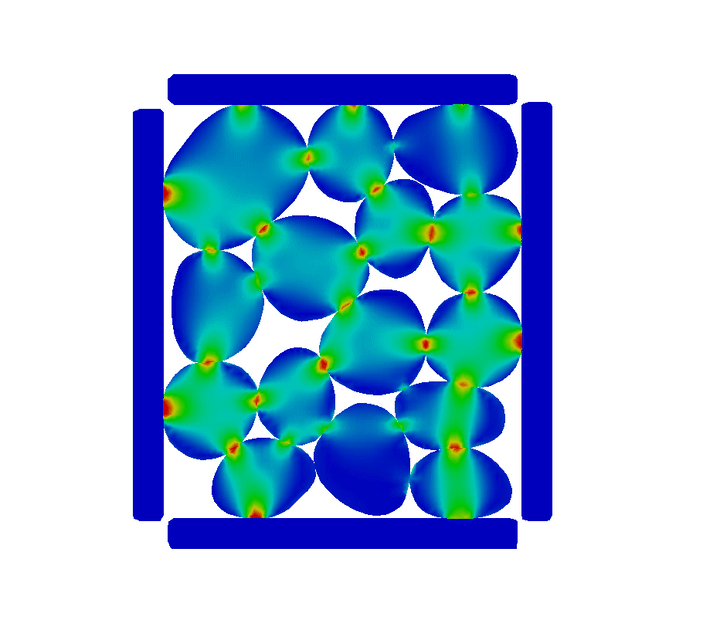
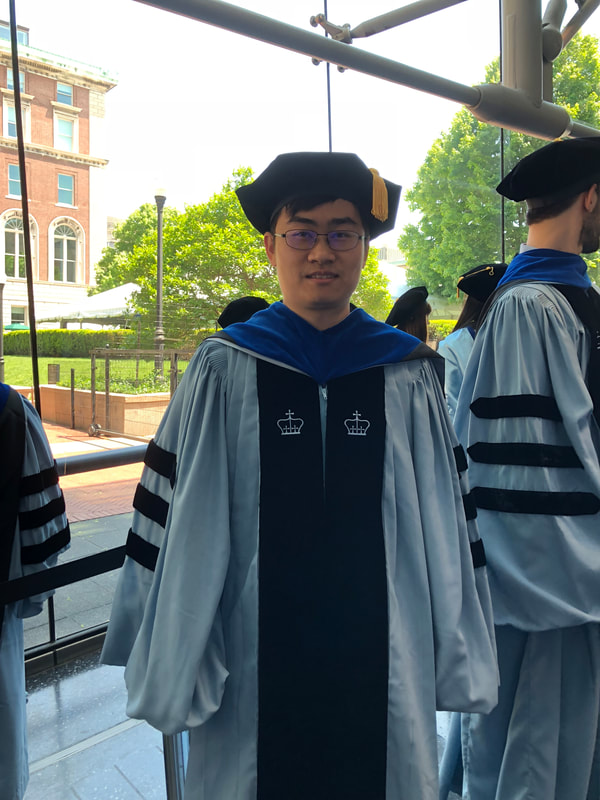
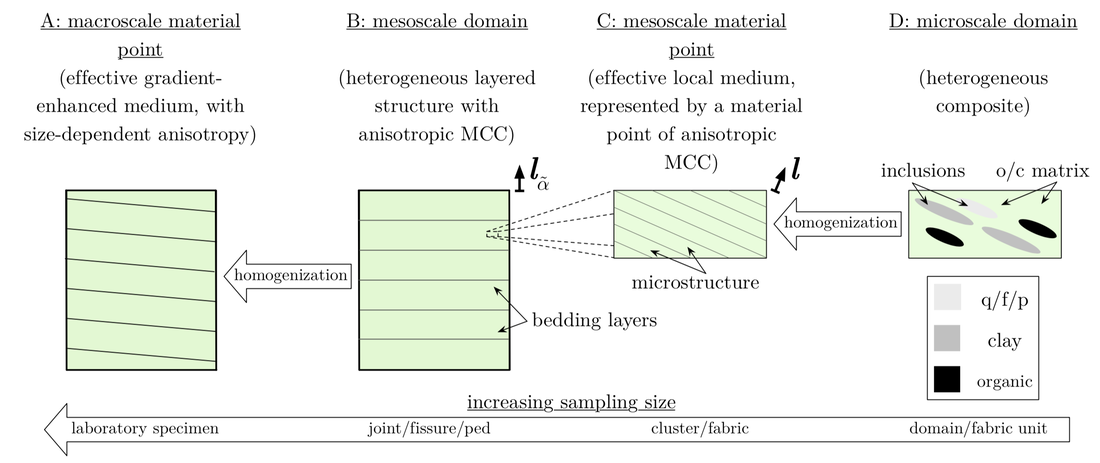
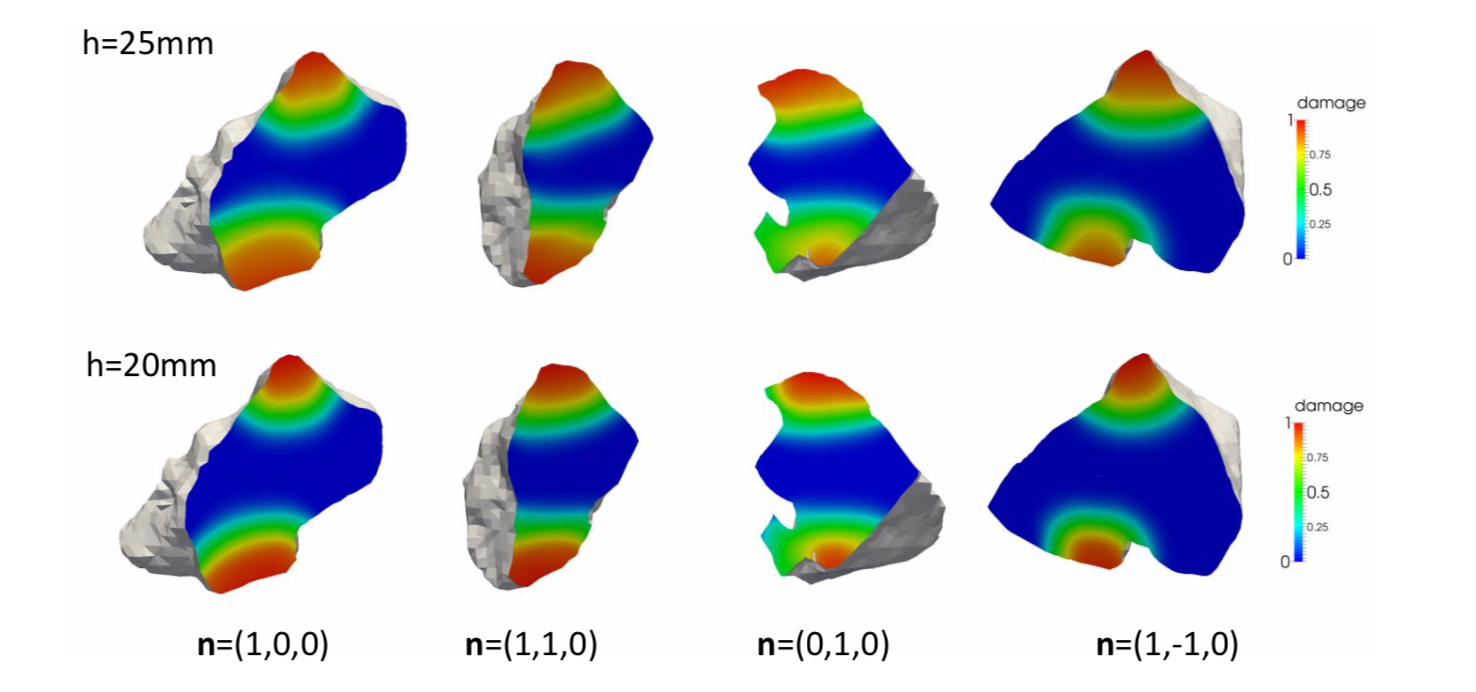
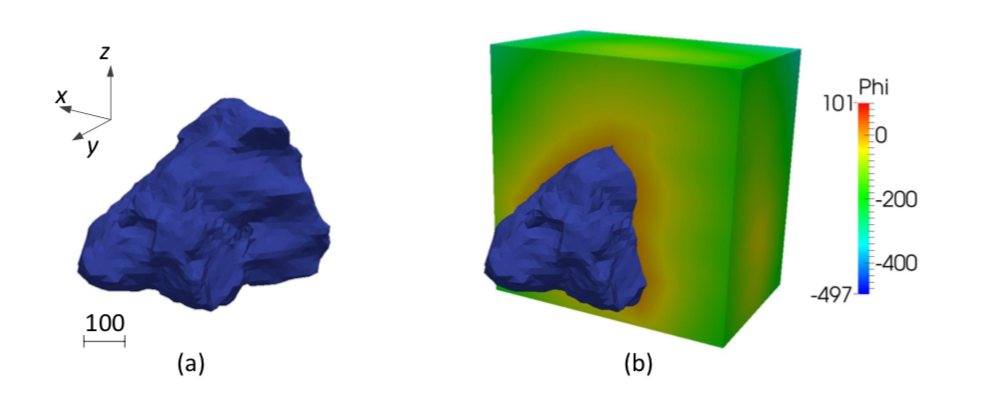
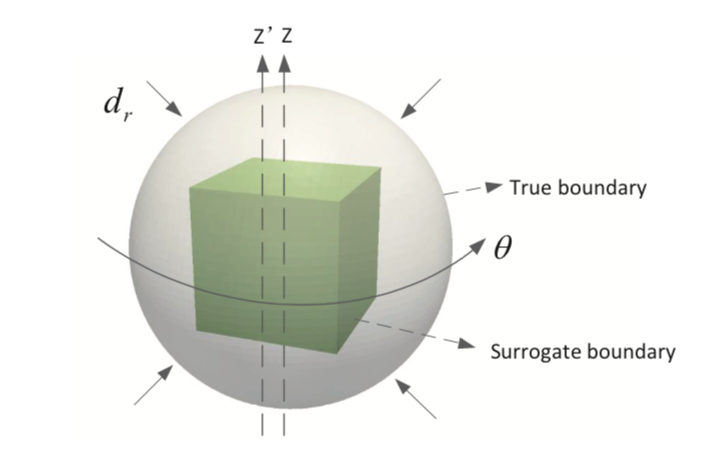
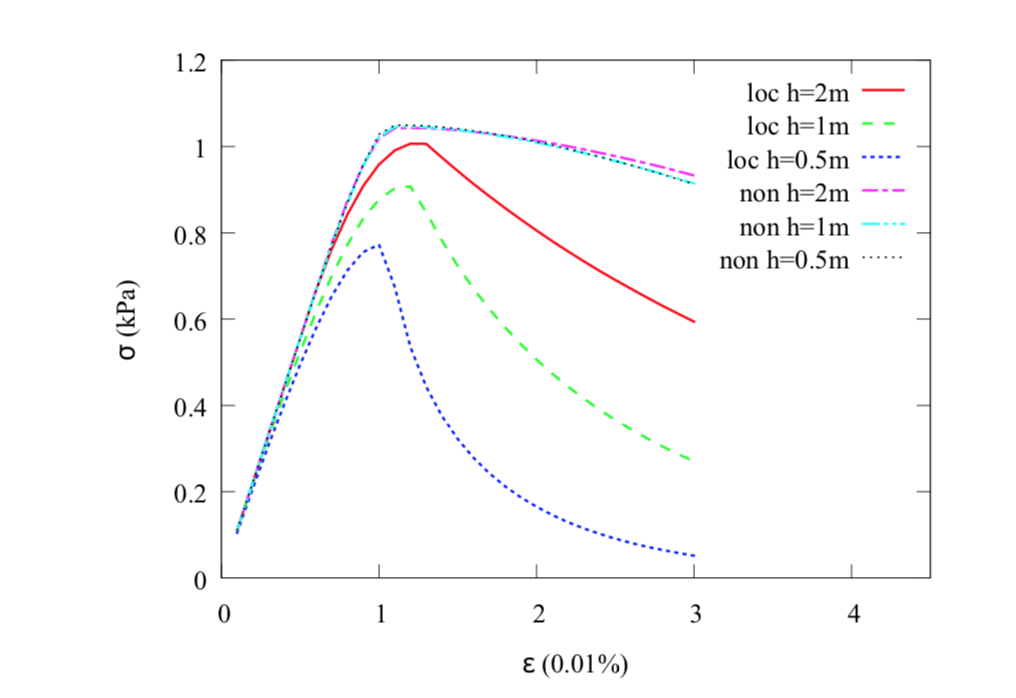
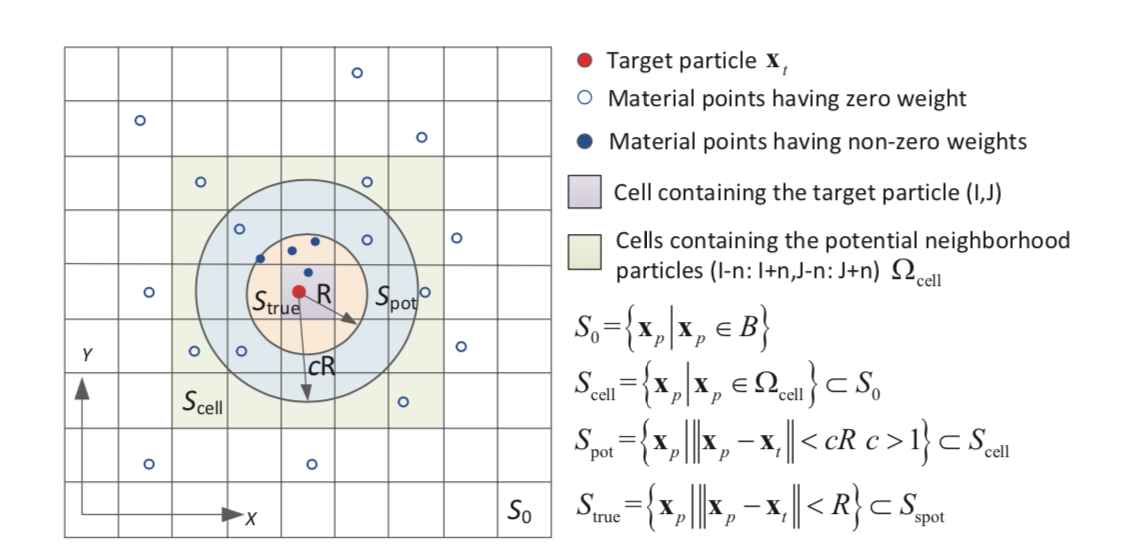
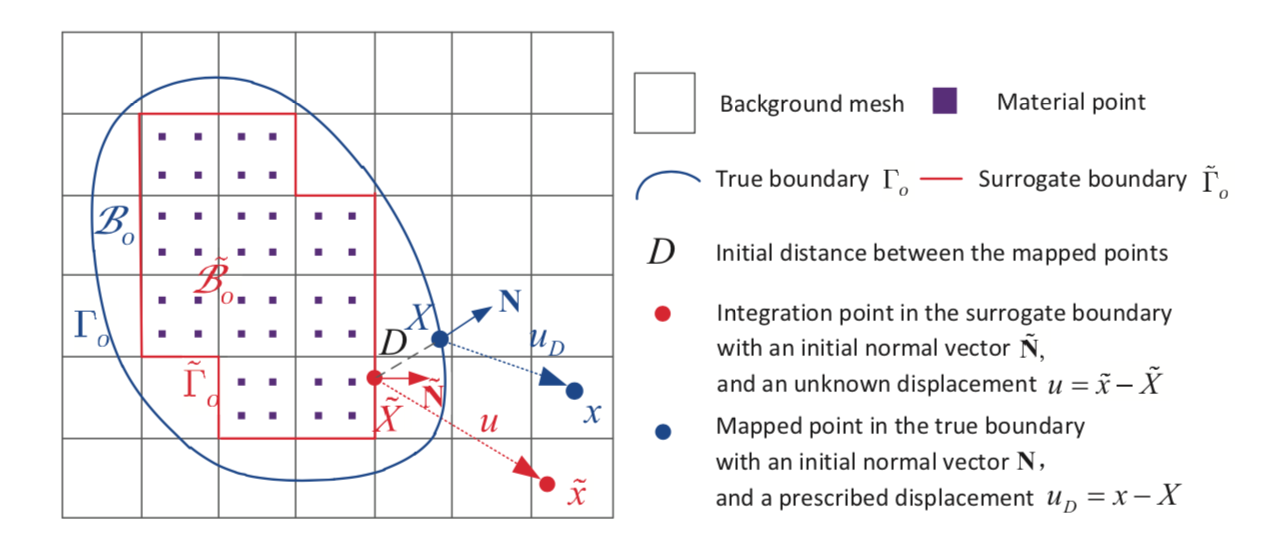
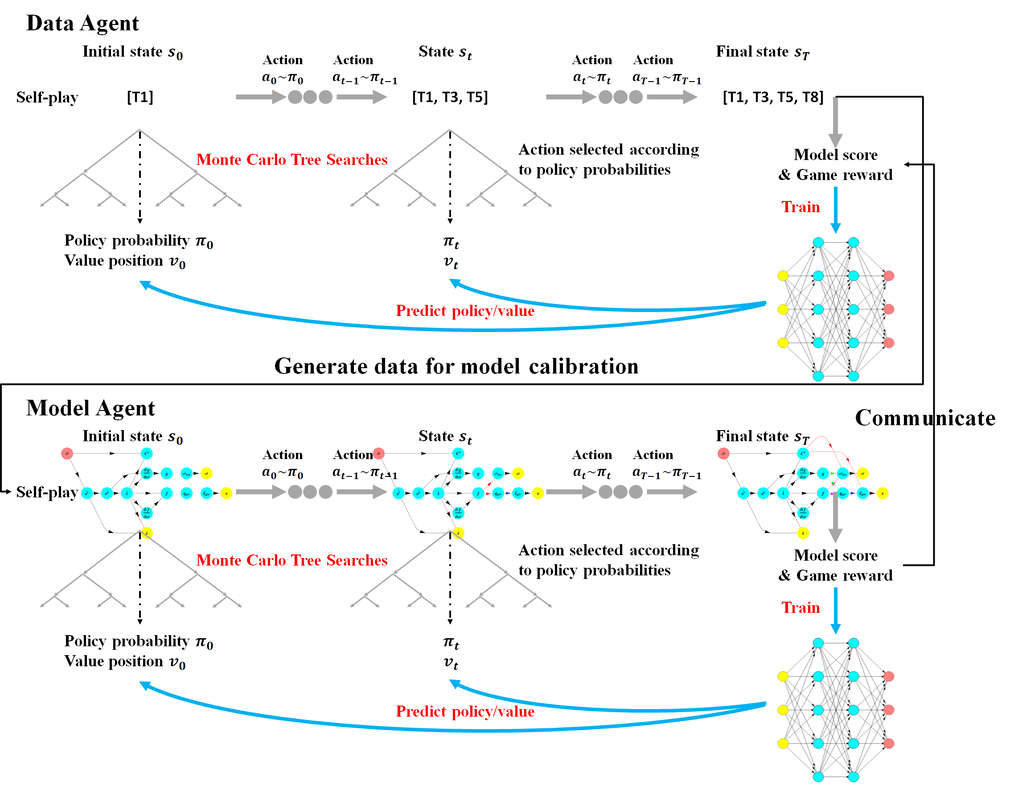
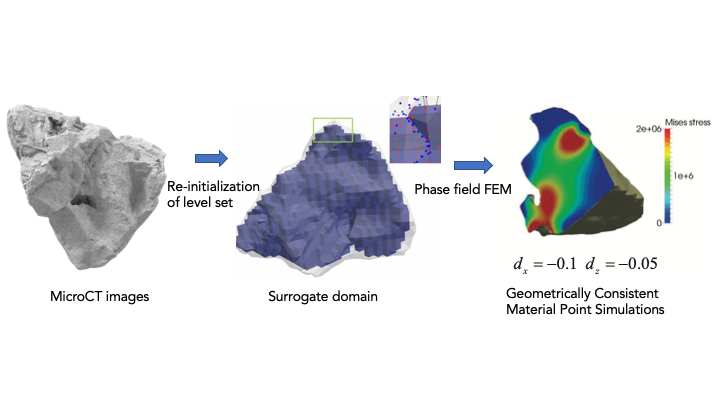

 RSS Feed
RSS Feed